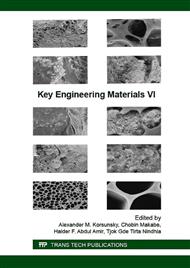[1]
P.K. Chattopadhyay, S. Chattopadhyay, N.C. Das, P.P. Bantyopadhyay, Impact of carbon black substitution with nanoclay on microstructure and tribological properties of ternary elastomeric composites, Mater. Design 32 (2011) 4696-4704.
DOI: 10.1016/j.matdes.2011.06.050
Google Scholar
[2]
X. Yang, MP Cohen, ML Senyek, DK Parker, SW Cronin, LT Lukich, US Patent 7342065B2 (2008).
Google Scholar
[3]
S. Praveen, P. Chatotopadhyay, P. Albert, V. Dalvi, B. Chakraborty, S. Chattopadhyay, Synergistic effect of carbon black and nanoclay fillers in styrene butadiene rubber matrix: development of dual structure, Composites Part A 40 (2010) 309-316.
DOI: 10.1016/j.compositesa.2008.12.008
Google Scholar
[4]
Z. Ali, H. Hong Le, S. Ilisch, T. Thurn-Albrecht, H. Radusch, Morphology development and compatibilization effect in nanoclay filled rubber blends, Polymer 51 (2010) 4580-4588.
DOI: 10.1016/j.polymer.2010.08.002
Google Scholar
[5]
H. Essawy, D. El-Nashar, The use of montmorillonite as a reinforcing and compatibilizing filler for NBR/SBR rubber blend, Polym. Test 23 (2004) 803-807.
DOI: 10.1016/j.polymertesting.2004.03.003
Google Scholar
[6]
M.T. Ton-That, F. Perrin-Sarazin, M.N. Bureau, K.C. Cole, J. Denault., Polymer-clay nanocomposites prepared in supercritical carbon dioxide, Ann. Mtg. of Polym. Proc. Soc. 20 (2004) 36.
Google Scholar
[7]
S. Hambir, N. Bulakh, P. Kodgire, R. Kalgaonkar, J.P. Jog, PP/clay nanocomposites: effect of clay treatment on morphology and dynamic mechanical properties, J. Appl. Polym. Sci. 81 (2001) 1786-1792.
DOI: 10.1002/app.1611
Google Scholar
[8]
Y. Lyatskaya, A.C. Balazs, Modeling the phase behavior of polymer-clay composites, Macromol. 31 (1998) 6676–6680.
DOI: 10.1021/ma980687w
Google Scholar
[9]
J.S. Hong, Y.K. Kim, K.H. Ahn, S.J. Lee, C.Y. Kim, Interfacial tension reduction in PBT/PE/clay nanocomposite, Rheol. Acta. 46 (2007) 469-478.
DOI: 10.1007/s00397-006-0123-1
Google Scholar
[10]
R.K. Shah, D.R. Paul, Polyolefin-organoclay nanocomposites: Properties, morphology and applications, Ann. Mtg. of Polym. Proc. Soc. 21, (2005) 8970.
Google Scholar
[11]
P.J. Yoon, T.D. Fornes, D.L. Hunter, D.R. Paul, Formation and properties of nylon 6 nanocomposites, Polymer 43 (2002) 6727-6741.
DOI: 10.1016/s0032-3861(02)00638-9
Google Scholar
[12]
C. Zilg, R. Thomann, R. Mülhaupt, J. Finter, Polyurethane nanocomposites containing laminated anisotropic nanoparticles derived from organophilic layered silicates, Adv. Mater. 11 (1999) 49-52.
DOI: 10.1002/(sici)1521-4095(199901)11:1<49::aid-adma49>3.0.co;2-n
Google Scholar
[13]
T. Lan, T.J. Pinnavaia, Clay-reinforced epoxy nanocomposites, Chem. Mater. 6 (1994) 2216- 2219.
DOI: 10.1021/cm00048a006
Google Scholar
[14]
J.T. Kim, T.S. Oh, D.H. Lee, Preparation and characteristics of nitrile rubber (NBR) nanocomposites based on organophilic layered clay, Polym. Int. 52 (2003) 1058.
DOI: 10.1002/pi.1110
Google Scholar
[15]
L.T. Vo, E. Giannelis, Compatibilizing poly(vinylidene fluoride)/nylon-6 blends with nanoclay, Macromol. 40 (2007) 8271–8276.
DOI: 10.1021/ma071508q
Google Scholar
[16]
A. Mostafa, A. Abouel-Kasem, M. Bayoumi, M. El-Sebaie, The influence of CB loading on thermal aging resistance of SBR and NBR rubber compounds under different aging temperature, Mater. Design 30 (2009) 791-795.
DOI: 10.1016/j.matdes.2008.05.065
Google Scholar
[17]
S. Rooj, A. Das, K. Stockelhuber, N. Mukhopadhyay, A. Bhattacharyya, D. Jehnichen, G. Heinrich, Pre-intercalation of long chain fatty acid in the interlayer space of layered silicates and preparation of montmorillonite/natural rubber nanocomposites, Appl. Clay Sci., (2012).
DOI: 10.1016/j.clay.2012.03.005
Google Scholar
[18]
A. Choudhury, A. Bhowmick, M. Soddemann, Effect of organo-modified clay on accelerated aging resistance of hydrogenated nitrile rubber nanocomposites and their life time prediction, Polym. Degrad. and Stabil. 95 (2010) 2555-2562.
DOI: 10.1016/j.polymdegradstab.2010.07.032
Google Scholar
[19]
J.A. Cornell, Experiments with Mixtures: Designs, Models, and the Analysis of Mixture Data, John Wiley & Sons, Inc., New York, (2002).
Google Scholar


